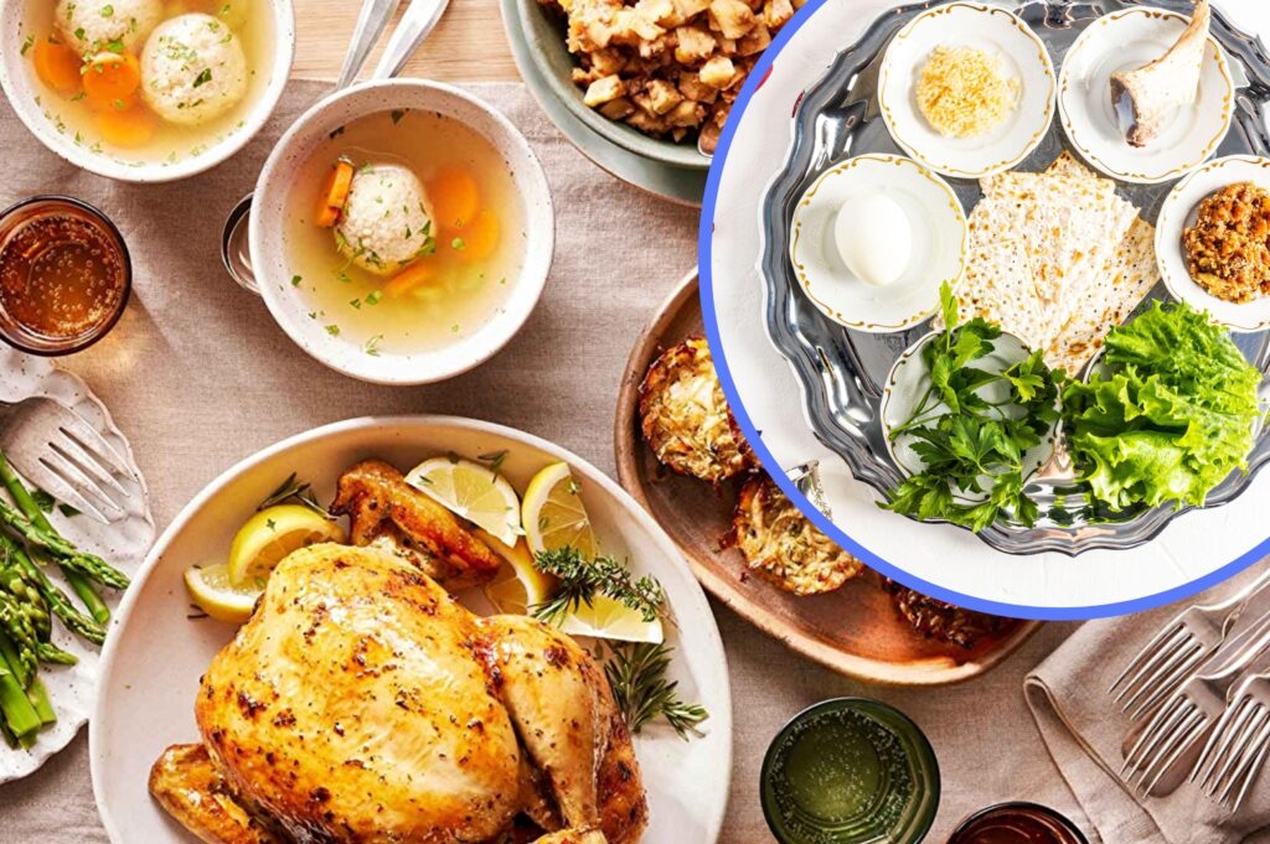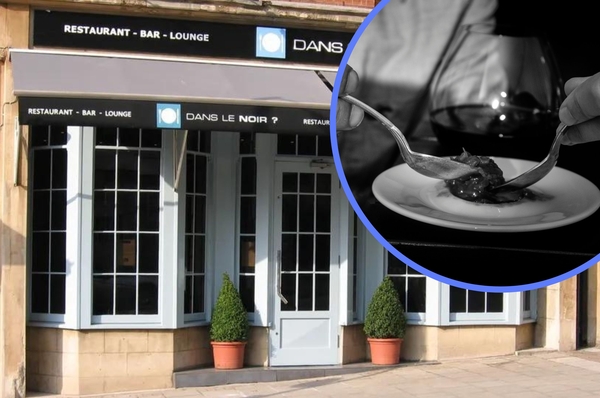features
What food do you eat on Passover? A deep dive
08 Mar 2023
7m

What do you eat on Passover? If you don’t observe it year on year, you might not know the traditional Passover food that is consumed over the religious holiday.
But there are over 15 million Jewish people around the world, many of whom mark the occasion annually by gathering with loved ones, making a Passover meal and eating only unleavened bread.
If you want to learn more about Passover, the food eaten and how it is celebrated, we’ve got the answers below.

Passover food is very symbolic (Credit: Alamy)
What is Passover and why is traditional Passover food important?
Passover (or Pesach, as it is called in Hebrew) is a holiday that marks the moment the Jewish people were freed from Egypt, as referenced in the bible.
Jewish people traditionally retell this story (found in the Old Testament’s Exodus) year on year, teaching the younger generations and also ensuring that they personally don’t ever forget the struggle their ancestors went through.
Passover lasts for eight days, and prayer, music and food are all important ways that the Jewish people recount the religious story – specifically during a meal called the seder (which takes place on the first night, and sometimes the second in some diaspora communities).
Today, whether religious or not, the seder is symbolic for many Jewish people. It isn’t just about remembering the biblical story but relating it to wider issues going on in the world today.
The food eaten during this time plays a really symbolic part in doing just that.
READ MORE: Chefs share naturally vegan foods from around the world
What are the 6 foods of Passover?
The Passover seder meal features what is known as a seder plate, and this holds six particularly emblematic food items.
These play a role in retelling the Jewish people’s escape from Egypt and are each either eaten or referred to at a different time.
The six items on the seder plate are:
1. Matzah

Matzah is the most well known food eaten on Passover (Credit: Alamy)
Matzah is an unleavened flatbread (like a cracker), which is perhaps the most well known food eaten at Passover.
We’ll go into more detail about how that came to be later, but it plays a particularly important part in the seder meal, where you’ll see three whole matzot (which is plural of matzah) in prize position on the plate.
These are all steeped in tradition. It’s customary that the middle matzah is broken apart and hidden around the house for kids to find (it’s known as the afikoman). The top matzah and the other half of the middle one is blessed with a prayer and the bottom matzah makes something known as the Hillel sandwich (read on for more info on that).
2. Charoset

Charoset is a nut and fruit paste (Credit: Alamy)
This is a paste made out of nuts, fruits, spices and wine.
Charoset is meant to represent the cement Jewish people used to build structures for the Egyptians when they were slaves.
Despite its dark meaning, the flavour profile of this Passover food is sweet, in contrast to some of the other items on the seder plate.
3. Maror (bitter herbs)

Horseradish is often used as a bitter herb (Credit: Alamy)
Traditionally, the seder plate features bitter herbs which symbolise the bitterness of slavery faced by the Jewish people faced in the bible.
Romaine lettuce or endives are often eaten here, due to their progressively sharp aftertaste, whilst horseradish is another very popular choice on seder plates.
At one point in the seder the maror is combined with charoset and matzah to create a makeshift sandwich (mentioned above).
The sandwich is eaten at a specific point of the seder meal, and is meant to emulate a traditional Passover meal eaten by Hillel, one of the most famous Jewish scholars.
READ MORE: Ottolenghi and Noor Murad speak to Twisted about the do’s and don’ts of fusion food
4. Shank bone

The shank bone symbolises ancient sacrifice (Credit: Alamy)
The shank bone (or Zeroah) is just for display, but it’s a really symbolic object on the Passover plate, too.
It’s a reference to the first Passover offering in the bible, where a lamb would have been sacrificed. Back in the time of the bible, the lamb would have then been consumed during the seder meal.
Today, some people use another object like a roasted beet in place of a bone, especially if they’re vegetarian.
5. Karpas and salt water

Parsley is typically used for the Karpas (Credit: Alamy)
Karpas is another vegetable (other than the bitter herb) that sits on the seder plate and is typically eaten with salt water at the start of the seder.
Some of the European Jewish diaspora use a potato here whilst you’ll commonly see parsley or green onion used, too.
The dipping of this vegetable in salt water is meant to symbolise the tears shed by the enslaved Jewish people.
6. Beitzah (egg)

Egg is another Passover staple (Credit: Alamy)
The egg hard boiled or roasted, and is also very symbolic. It’s meant to reference a festival sacrifice named as koban chagigah, which took place during the time of the temple in Jerusalem.
This ancient sacrifice would have been a meat offering, but the egg is used to mark it today. It holds special meaning because eggs are typically served to mourners after Jewish funerals. The egg indicates the circle of life, as it also has links to birth and reproduction.
Do you eat the egg on Passover?
Whilst, like the bone, some families only look at the egg on the seder plate, others actually eat one dipped in salt water as part of their Passover meal.
The egg isn’t mentioned in the Haggadah, which is a book that tells Jewish people an order to celebrate Passover.
In fact, nobody really knows where the tradition comes from, although the symbolism is obvious.
As mentioned above, the two ingredients connote tears, death and new life, and give participants in the seder meal a lot to think about as they eat it.
What is traditional food for Passover?
The seder plate is the one constant on Passover, but other than that food traditions vary from family to family.
After the seder, a meal is served which is in line with the dietary rules of Passover (we’ll get to those in a second).
Other than this, families can eat what they please, though they often go for traditional Jewish food given it’s a religious occasion.
READ MORE: How to prep, cook and eat rhubarb

Traditional Jewish food is often eaten on Passover (Credit: Alamy)
To give you an idea, commonly eaten Passover food includes:
- Matzo ball soup (a soup with dumplings made from matzah meal, beaten eggs, water, and fat.)
- Gefilte Fish (fish dumplings)
- Beef brisket
- Roast chicken
- Potato kugel (a grated potato dish)
- Tzimmes (a root vegetable side dish)
The above are some of the the most typical Jewish meals, and originate from the Ashkenazi Jewish diaspora, in Eastern Europe.
The Sephardic Jewish people, hailing from the Mediterranean, enjoy different food traditions over Passover, including the consumption of artichokes, leeks and fava beans, according to My Jewish Learning.

Gefilte fish is also a Passover favourite (Credit: Alamy)
What foods are forbidden during Passover?
Many people of Jewish faith chose to eat a kosher diet all year round, which limits certain items (like some meats and shellfish) by the religion’s law. You can read more about that here.
However, on top of this there are several more restrictions over what can be eaten during Passover (not just the seder meal, but for the full eight days).
Let’s break it down.
Why do you eat unleavened bread at Passover?
Bread is forbidden during Passover, which is why unleavened bread (or matzah) is eaten instead.
This is to commemorate the fact that when Jewish people fled Egypt in haste, they didn’t have time to let their bread rise.
As we mentioned above, matzah is a flatbread made from flour but baked for just long enough that it doesn’t rise.
Bread isn’t the only food that is traditionally avoided over Passover, in line with Jewish law. Many Jewish families keep kosher for Passover, which prohibits several more ingredients for just over a week.
READ MORE: What is blonde chocolate? The lowdown

You can’t eat leavened bread on Passover (Credit: Alamy)
What is kosher for Passover?
Wheat, spelt, barley, oats and rye are known as chametz, and they’re forbidden over Passover. This derives from the fact that leavened bread is forbidden.
All of the ingredients listed are leavening agents – which means they can be used in dough to make something rise – and they’re a no-go, too.
Pasta, pastries, breadcrumbs and crackers, or anything else made from these ingredients are also banned. Plus, you can’t eat pizza, cakes or biscuits if they contain flour made from chametz, either.
Matza is the only item containing wheat flour that’s allowed to be eaten, and that’s because the way it is cooked ensures it isn’t leavened.
Some Ashkenazi families take the rules a step further and also traditionally cut out rice, lentils, chickpeas and beans, for fear that they could be contaminated by chametz. It is also thought that they too closely resemble them.

Cupboards are often cleared for Passover (Credit: Alamy)
READ MORE: How to prep, cook and eat wild garlic
Households who are particularly observant to Passover rules will also rid their homes of chametz altogether, to avoid eating anything contaminated with it.
Some will bring out different crockery and cutlery for the eight day period.
Of course, exactly what Jewish people cut out of their diets (if anything at all) depends on the denomination of Judaism they belong to, and how observant they are.
When is Passover 2023?
Passover 2023 starts on the evening of April 5th and continues until April 13th.
Those observing the first seder night will mark it on night one, and some people have a second seder on night two, as well.
The date of Passover changes every year because it is guided by the Hebrew calendar, which is based on lunar cycles.
Last year, Passover celebrations begun on April 15th, and in 2021 it fell on March 27th.
Meanwhile, in 2024, Passover is expected to fall on April 22nd.
.jpg_8zBQx1?tr=w-600&config=eyJuYW1lIjoiZWRpdGFibGUgdGVtcGxhdGUgKDgyKS5qcGciLCJhbHRlcm5hdGl2ZV90ZXh0IjoiZWRpdGFibGUgdGVtcGxhdGUgKDgyKS5qcGciLCJjb29yZGluYXRlcyI6eyJkZXNrdG9wIjp7ImxlZnQiOjAsInRvcCI6MCwicmlnaHQiOjEsImJvdHRvbSI6MC42Nn0sInRhYmxldCI6eyJsZWZ0IjpudWxsLCJ0b3AiOm51bGwsInJpZ2h0IjpudWxsLCJib3R0b20iOm51bGx9LCJtb2JpbGUiOnsibGVmdCI6bnVsbCwidG9wIjpudWxsLCJyaWdodCI6bnVsbCwiYm90dG9tIjpudWxsfX0sIndpZHRoIjozMTcyLCJoZWlnaHQiOjIxMDl9)
.jpg_NYLaso?tr=w-600&config=eyJuYW1lIjoiZWRpdGFibGUgdGVtcGxhdGUgKDgxKS5qcGciLCJhbHRlcm5hdGl2ZV90ZXh0IjoiZWRpdGFibGUgdGVtcGxhdGUgKDgxKS5qcGciLCJjb29yZGluYXRlcyI6eyJkZXNrdG9wIjp7ImxlZnQiOjAsInRvcCI6MCwicmlnaHQiOjEsImJvdHRvbSI6MC42Nn0sInRhYmxldCI6eyJsZWZ0IjpudWxsLCJ0b3AiOm51bGwsInJpZ2h0IjpudWxsLCJib3R0b20iOm51bGx9LCJtb2JpbGUiOnsibGVmdCI6bnVsbCwidG9wIjpudWxsLCJyaWdodCI6bnVsbCwiYm90dG9tIjpudWxsfX0sIndpZHRoIjozMTcyLCJoZWlnaHQiOjIxMDl9)
